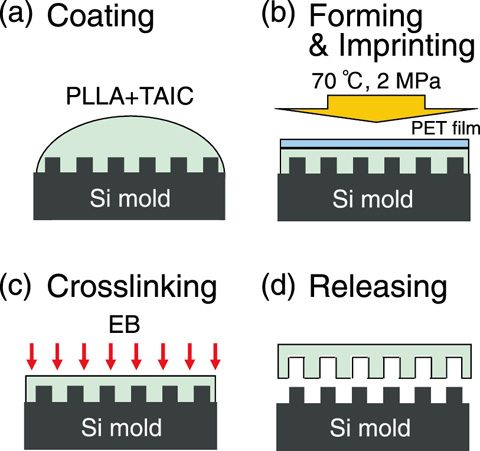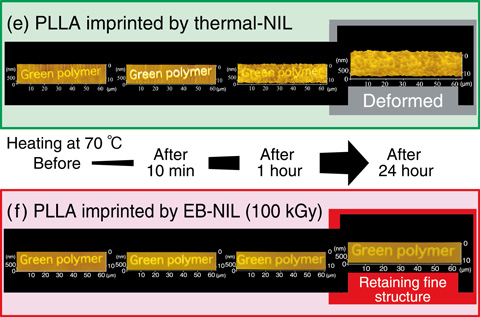
Fig.5-15 Steps of the electron beam (EB) nanoimprint lithography process

Fig.5-16 Thermal durability of PLLA imprinted pattern using conventional and EB nanoimprint lithography methods.
Research and development on the preservation of the global environment is progressing in various fields. It is desired to replace petroleum-based plastics with plant-based alternatives with the goal of establishing a recycling-oriented society. Poly(L-lactic acid) (PLLA), prepared from lactide produced in the fermentation of sugar or corn starch, is the most promising candidate for replacement of petrochemical plastics because of its high strength, transparency, and melting point. However, its low thermal deformation temperature is a critical issue for industrial applications. Therefore, we improved the heat resistance of PLLA using a radiation crosslinking technique with triallyl isocyanurate (TAIC) as the crosslinking agent and applied the crosslinking technology to fabricate fine structures on PLLA.
PLLA fine structures are expected to be used for fine optical components and lab chip materials, etc. Thermal nanoimprint lithography (T-NIL) is the conventional and cost-efficient method for the mass production of nanostructures in polymers. However, the obtained PLLA fine structures were deformed by heating at 70°C, which is the softening temperature of PLLA. Electron beam nanoimprint lithography (EB-NIL) was proposed as a novel method for fabricating micro-/nano-structures and improving the heat resistance of PLLA via crosslinking. As shown in Fig.5-15, the EB-NIL method consists of four steps: (a) coating of a 3% PLLA/TAIC (95/5) solution in chloroform by dropping into a silicon (Si) mold, (b) forming and imprinting the sample via hot-pressing at 2 MPa and 70°C for 20 min, (c) crosslinking using EB irradiation with doses from 10 kGy to 500 kGy at room temperature under vacuum, and (d) releasing the PLLA fine structure from the Si mold.
Fine structures were imprinted on PLLA using T-NIL and EB-NIL and observed via atomic force microscopy, as shown in Fig.5-16. The micro-/nano-sized fine structures of both imprinted patterns were maintained at room temperature. However, the fine structure produced on the PLLA using T-NIL was completely deformed after heating at 70°C. On the other hand, the patterns imprinted on PLLA using EB-NIL (100 kGy) were retained, even after heat treatment at 70°C for 24 h, due to its high resistance to thermal deformation. The nanoimprinted, environmentally friendly plastics are expected to be used for fine optical components and lab-on-a-chip materials, etc.
Our research was accomplished by the joint research of Waseda University and Osaka University. A part of this project was supported by the Nanotechnology Network Project (Handai Multi-functional Nanofoundry, Osaka University) of the Ministry of Education, Culture, Sports, Science and Technology of Japan (MEXT).